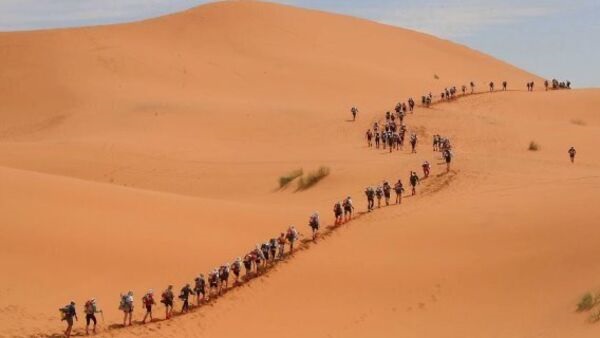
We need Africa. We need a land that is still virgin, where there are great mineral resources and endless possibilities for agriculture and pastoralism. A land where human beings are hungry for everything, but especially for hope and a future. A land where neo-colonialism continues to destroy, when it would be more sensible and profitable to build – to defeat the warlords not only militarily, but above all culturally and economically. So we need the Sahel, which today is an immense desert that occupies the vast majority of the northern territory of this continent, and in which we should invest all our technological and economic capacities, so that in a few years we will have a true and reliable partner instead of territories torn apart by violence that we Westerners exploit with the same brutality and disregard for life that are characteristic of the everyday life of those nations.
Even in the Sahel, there are poorer and less poorer nations. Over the centuries, humanity has also adapted in terribly hostile regions[1]. Niger is one of these: one of the hottest countries in the world, whose rainy season lasts less than two months, and the country, slapped by the monsoon, suffers terrible floods. Otherwise, one suffers from thirst. Just a few days ago, in late October, 1.3 million people were displaced, more than 200,000 were destroyed and more than 600 people lost their lives due to torrential rains[2]. In 2019, thunderstorms, especially in Agadez, Diffa, Maradi and Zinder, affected 260,000 people, disrupting daily activities and causing severe livestock losses[3]. Agriculture, along with pastoralism, is the primary source of livelihood and this, in such a hostile climate, becomes a serious weakness.
Niger also has other sad records: it is one of the least developed countries in the world – in 2018, it was in last place among the Third World countries and, according to a World Bank report of 2021, more than 10 million people (41.8% of the population, which is growing due to the fact that the birth rate assigns 7 children per woman[4], and as many as 8.5 in the city of Zinder[5]) live in extreme poverty[6]; in 2020, 2.7 million of them needed humanitarian assistance[7]. Today, the number of people at risk of starvation[8] has risen to 4.4 million, a 91% increase over the same period last year[9].
A country of unspeakable suffering
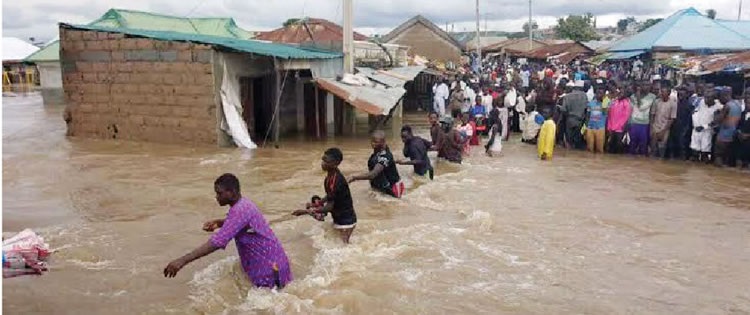
September 2020: Nigeris from the village of Soleja try to save themselves during the flooding[10]
The economy is a total disaster: after growing by 5.8 % in 2019, it slows down to 3.6 % in 2020 and drops again to below 1.5 % in 2021. It relies partly on the extraction and export of uranium, of which it is the fourth largest producer in the world: in 2021, production reached 2,248 tU[11]. But for Niger it is a mockery: the mining companies are controlled by the French government and uranium, despite accounting for 70% of exports, contributes only 5% of the national GDP (compared to 40% for agriculture), and leaves behind environmental devastation[12].
The hygienic conditions and lack of health care affect any hope of growth based on the products of the land, so the government, unable to free itself from the yoke of the French, now hopes for oil: its two large sedimentary basins, covering more than 90% of the national territory (Ullémenden, Tamesna and the Graben system in Djado), guarantee a production of 20,000 barrels per day so far, but the discovery of new deposits and impressive investments will soon bring production to as much as 110,000 barrels per day, 90,000 of which are destined for export[13], and this could represent a considerable economic contribution, provided everything does not result in yet another pillage.
Ever since its independence from France in 1960, Niger has had autocratic and military governments, which have followed one another in a series of coups; only in 2011, with the election of President Mahamadou Issoufou, welcomed even by international observers, was a semblance of democracy born[14]; but the subsequent elections, in 2016, took place amidst serious irregularities[15]. In 2020, amid violent protests by opponents, the former interior minister Mohamed Bazoum of the Nigeris Party for Democracy and Socialism (PNDS Tarayya) came to power[16]. A power run with brutal repression and arbitrary arrests[17].
Freedom of the press, guaranteed on paper, is subject to continuous imprisonment and intimidation, as is freedom of association and organisation; freedom of religion and worship is legally guaranteed, but in fact, with the alibi of security, there is tight control, which among other measures, from February 2021, has decided to suspend the Internet[18]; in June of the same year, Twitter was suspended: “It is a platform for critics and opponents”[19]. Women are at the end of their tether: early marriages are the norm, genital mutilation is widespread (despite the ban), abuse and rape go unpunished, domestic violence against women is de facto tolerated – slavery has been illegal since 2003, but human trafficking is a thriving reality affecting thousands of people[20]. Chauvinism is pre-eminent, and it is the weakest minorities, such as refugees, who are denied any rights, who suffer[21].
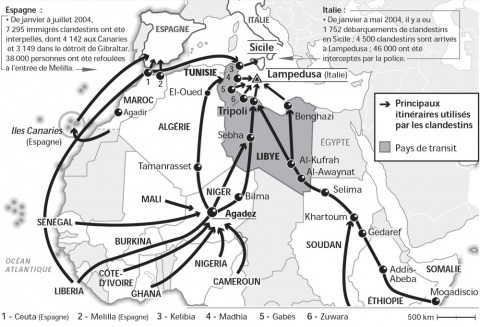
Map of migration flows across Africa and the Mediterranean[22]
Drought, floods, hunger, disease, persecution, corruption, armed gang violence, urban crime are some of the reasons that make this land a place from which to flee, but this is a luxury few can afford. Niger is more a land of transit for those fleeing from other states, dreaming of Europe, defying a thousand odds and all too often finding death. Niger is a formidable hub for migrants: the city of Agadez is considered the gateway from West Africa to the Sahara. Niger’s central role is due to the fact that Niamey, the capital, is part of the ECOWAS (Economic Community of West African States) free movement area, which allows migrants from the organisation’s other member states (including Nigeria, Benin, Burkina Faso, Mali, Algeria, Libya and Chad) to travel to Agadez without much hassle[23].
There are alternative routes connecting Africa to Libya (the western one, which passes through northern Mali, and the eastern one, which passes through Sudan), but the refugees know that they are very dangerous. Until 2016, having arrived in Agadez, the migrants rely on passeurs, who, for a few hundred dollars, take care of their movements to the Libyan south. A constellation of tribal affiliations then guarantees the traffic, while the control and securing of the migratory routes along the Niger-Libya corridor is ensured by local warlords (ethnic Tuareg, Tebu, Arab) [24]. All services that live off the complicity of the authorities, soldiers and police forces, as this dense network contributes to the livelihood of local communities[25].
International pressure is pushing the Niger authorities to implement Law 36 of May 2015, which militarises the Niger-Libyan border and, through repressive measures, succeeds in closing the Agadez route[26]. The blocking of flows, the arrest of the passeurs and the seizure of vehicles cause profound socio-economic repercussions: anger towards the authorities grows[27], triggering angry violence. However, the effectiveness of the measures is short-lived: in a short time, new organisations flourish, forced to choose more dangerous routes, increasing fares, and this encourages the development of criminal networks that link migrant trafficking to drug routes[28]. One of the effects of this destabilisation is the increase of displaced persons and asylum seekers from Niger in the region – and the rapid spread of thirst, hunger and disease.
The hell of Zinder
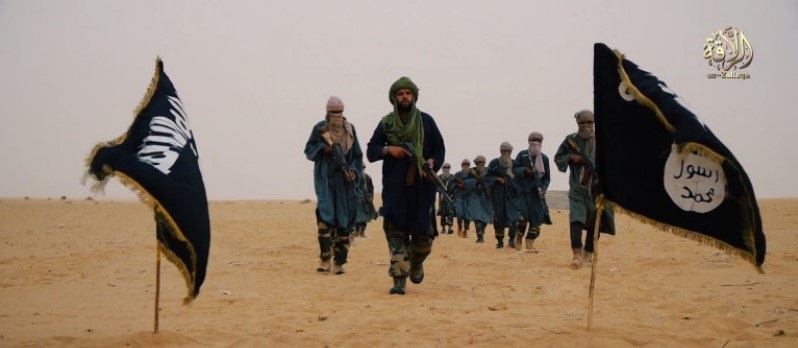
JNIM fighters, al-Qaeda affiliated, present in Niger since at least March 2017[29]
Niger is also a weak state, in which dozens of militias of different origins hide and thrive: some operate on the basis of ethnic claims, others in response to governmental mismanagement, others are fuelled by jihadism and desperation: there is the Boko Haram insurgency[30] in the Lake Chad Basin and the Islamic State in West Africa Province (ISWAP), a splinter group of Boko Haram[31], not far away; there is the Islamic State of the Greater Sahara (ISGS) [32] in northern Tillabéri, and the al-Qaeda affiliated Jama’at Nusrat al-Islam wal-Muslimin (JNIM)[33] in south-western Tillabéri: all perpetrators of horrendous crimes including rapes, murders and forced recruitment of children[34].
Then there are the Armed Non-State Groups (GANE) [35], which in Diffa and Tillabéri proliferate and commit abuses and violence, causing massive displacements[36]. And there is organised and violent banditry in southwestern Niger, along a border strip in the towns of Maradi and Dogondoutchi, dedicated to kidnapping and cattle theft[37], and there are tribal conflicts between settled farmers and semi-nomadic pastoralists over access to resources compromised by climate change[38], which often become levers for jihadist groups.
Mohamed Bazoum, the current president, is the preferred interlocutor for the West in the war on terror in the Sahel. After the military coups in Mali and Burkina Faso, there is no other choice: despite the attempted coup in March 2021, despite the high levels of corruption[39] and general instability, the Niger government is still considered the least problematic in the area[40]. This makes the area a counter-terrorism hub for the French army, even though some civil society organisations, such as Tournons la Page[41], are against foreign bases in the country: protests against ‘neo-colonialism’ are recurrent in Niamey and other large cities, in line with the popular anti-French sentiment spread throughout the Sahel[42]. But the most serious problems are hidden in cities that nobody talks about, that nobody knows anything about – like Zinder.
Situated in the south-east of Niger, Zinder is the third largest city in the country and the capital of the most populated region of Niger: the strong demographic increase and miserable social conditions have turned it into a powder keg, where more than 70% of the population of the region is made up of minors, almost all of them without work and without hope of obtaining it: while Zinder’s 1977 census counted 1,002,225 inhabitants, the 2012 census counted 3,539,764, 71.6% of whom are under 25 years old and have one of the lowest school enrolment rates (45.8%) in the country; the national school enrolment rate was 68.4% in 2011 and 55% in 2014[43].
Zinder is the scene of daily violence, especially among young males, forged by despair, precariousness, illiteracy, alcoholism and endemic unemployment. In a civilised society without control, the law is made at home: organised gangs proliferate, and their young members are involved in acts of violence and drug trafficking. Yet Zinder is a city completely unknown to world public opinion.
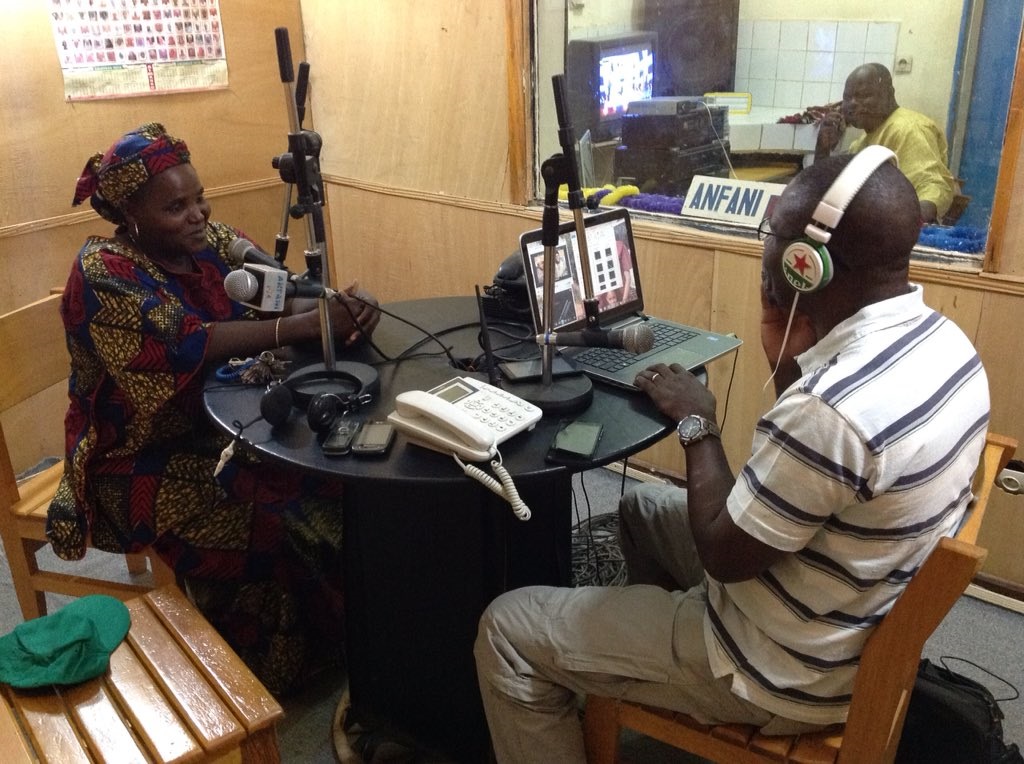
Radio Anfani in Maradi: the origin of Niger’s youth associationism[44]
Until, around 2010, the ‘Yan Palais’ was born, which in the Hausa language (an ethnic group of Sunni Islamic religion that culturally dominates the Zinder region[45]), means members of the ‘palace’: a group of young people who mythologise American gangs, borrowing their names, clothing, musical tastes, drug use, sexual behaviour and street violence. The ‘Palais’ is an aberrant drift of an earlier, peaceful culture in which young people organise themselves into self-managed social centres, called Fadas, and meet to socialise, listen to music, play games.
The Fadas were born in Zinder in the 1990s thanks to the spread of private radio stations. During a broadcast of the most famous, Radio Anfani, the station manager encourages the young people of Zinder to organise themselves, to take responsibility, to carry out civic activities, and then to report back to the radio station[46]. Within a few weeks, the first Fadas are organised. In each neighbourhood, young people clean the mosque, the cemetery or the streets, or plant trees; the Fada announces its next activity on the radio and invites other Fadas to join in; there is then a coordinating Fada that provides drinks and food for the participants[47].
The Fadas are a great success, and begin to change[48]. The groups begin to give themselves a more and more articulated and organised structure, hierarchies emerge at the top of which are the ‘elders’, who are at most 30 years old, but are a reference point for young people up to 12 years old, who receive a few coins or banknotes to acquire their obedience, or by simply forcing them with violence[49]. The areas they occupy are increasingly becoming haunts in which an attempt is made to recreate what does not exist in public spaces: a new social organisation, a vision that attempts to replace the institutional one, perceived as distant and adverse, with its own laws and unfortunately pervaded by violence[50].
There are hundreds of Palais (a census carried out in 2012 counted over 250 groups in Zinder alone[51], and another study arrived at 320[52]) scattered mainly in the suburbs, concentrated in very poor neighbourhoods such as Garin Malam and Kara-Kara: the latter is a place marked by the inauguration, in 1999, of a colony for lepers, a stigma that has created marginalisation, preventing the inhabitants from obtaining education and work, pushing them to beg amidst misery and violence, and which they organise into Fadas[53]. Each Palais is made up of between 10 and 25 members, armed with crude weapons such as knives and machetes, who engage in theft, fuel smuggling, rape, fights, even with other Fadas, and take advantage of street demonstrations organised by schools or trade unions to infiltrate and create havoc, burning down buildings and cars: clashing with the police is a source of pride for them[54]. The police seem powerless, they only scratch the surface[55].
Islamic radicalisation is gradually taking hold in the Palais[56]. The blame lies with economic and social instability, the absence of justice or, rather, the perceived inequality in its application[57]. In Niger, the numerous Islamic organisations spread their religious messages widely, but Christian communities also have their own important presence. Coexistence is by no means easy and mutual discrimination is common practice[58]. Interventions by the authorities in suppressing violence by one or the other religious group are perceived as retaliation by political interests[59]. Article 3 of Niger’s Constitution enshrines the separation of state and religion, but the fact that more than 98% of the population is Muslim undermines the principle of secularism, especially because of frequent religious interference by the political class.

Smuggled fuel sold along the roads of Zinder[60]
Zinder is an open-air laboratory of clashes on religious issues, as in the case of the ‘opération bujébujé’ in 1990, which consisted of harassing girls in the street wearing a skirt (bujé), considered religiously indecent[61]; or in the demonstrations against the family code and the organisation of the FIMA (Festival International de Mode Africaine) in 2000[62]; or in the violence against three churches in 2012[63], or in the attacks on churches and bars, which were set on fire in 2015 following the participation of President Mahamadou Issoufou in support of Charlie Hebdo[64]. The violent drift towards Christians is a growing phenomenon, and the presence of groups like Boko Haram only reinforces an extremist idea of Islam, seen as an instrument of force and power[65]. For the members of the Fadas, espousing Islamism becomes a necessity to consolidate their image as rulers and gives them a kind of legitimacy in the use of violence[66].
In an article of 8 March 2016 in Foreign Policy Magazine (‘Dead Man’s Market and the boys gangs of Niger’[67]) there is the first description of the Palais to the international public. The journalist offers a mercilessly violent picture of Zinder and the gangs, described as associations of serial killers. Interviews and detailed accounts illustrate a terrible lifestyle, where the glorification of violence frightens even the police: the city, according to the article, is ravaged by ‘days and nights of brutality’, street brawls, murders, rapes and armed robberies. There are ‘slashed bodies’, ‘crushed bones’ and machetes ‘worn out from years of cutting into bodies’[68].
A part of the article is dedicated to the possible risk of enlisting the gangs in the ranks of Boko Haram and reports on attempts at co-optation made as early as 2015 with meetings that took place in Zinder with the Yan Palais; RFI, the French public radio service, recounts when, in 2015, violent demonstrations broke out in response to the caricature of the prophet Mohammed published in the French magazine Charlie Hebdo: a black Boko Haram flag waved in the crowd[69].
According to Search for Common Ground in Diffa, a province in the south-eastern corner of Niger that Boko Haram has been targeting for years, young people receive thousands of dollars or new motorbikes to join the ranks of Boko Haram, and refusal is not an option: in this case we end up with a cut throat[70]. An expert on extremism in West Africa from Coventry University, reports that exploiting ‘unemployed young people who believe they have nothing to live for and are disillusioned with the state’ is a common practice for Boko Haram: ‘I would not be surprised if Zinder becomes Boko Haram’s next target’[71].
The report by Aicha Macky

One of the frames of the documentary set in the Fadas made by Aicha Macky[72]
The report ‘Dead Man’s Market and the boys gangs of Niger’ is disputed. The boys involved in the story do not take kindly to being described as hardened criminals, and agree that the report is full of exaggerations. Ibrahim Yahaya Ibrahim, a doctoral student in Political Science at the University of Florida and a resident of Zinder, denies that the boys in Zinder behave like animals and states that the Western media tend to negatively emphasise the African reality, using an old ‘colonialist’ style[73].
The offending article also neglects, according to Ibrahim Yahaya Ibrahim, the efforts made by the government to try to curb lawlessness which, according to the analyst, is not so different from that of some Western countries: suffice it to think that, taking the year 2012 as an example, the worst in terms of violence, in Zinder the crime rate was 6.28 crimes per 1,000 inhabitants, while the crime rate also in 2012 in Edison Park, the safest neighbourhood in the American city of Chicago, was 1.5 times higher, or 9.24 crimes per 1,000 inhabitants[74]. Even the alleged contamination of the Palais by Jihadist groups is, according to Ibrahim Yahaya Ibrahim, unfounded and driven by prejudice: in fact, the youth of Zinder are much more inspired by American gangs and pop stars than by Islamic militants, as the Palais graffiti on the walls of Zinder shows: They evoke DMX, Bad Boyz, Outlaw, Black Power and Gangsters City, and the Yan Palais wear saggy trousers, dreadlocks and crested hairstyles like in American ghettos[75].
The possible debate is erased by an astonishing document: Aicha Macky, a sociologist and filmmaker from Zinder, made a feature film[76] in 2021 that delves into the Palais’ raw reality. The result is impressive, everything is told without filters: the noises, voices, lights, the dusty chaos of the streets, the extreme close-ups on the deep scars of men and women, the lost, dreamy, frightened, aggressive, smiling, lost but all extraordinarily authentic looks, throw in our faces the drama and despair of those who are forced to be part of a social context where no law reigns, except the do-it-yourself one.
Everything is uncertain, the future can only be dreamt of, no one knows how to manage to pay for their children’s schooling or the ultrasound scan for the baby on the way, but not even how to put together dinner for the evening. The state is absent, everyone feels betrayed by the government, and so they organise their lives by uniting in groups to make sense of the passing time and the daily struggle to survive, creating self-defence and socialisation centres, responding to violence with violence, smuggling petrol from neighbouring Nigeria and selling it at half price along the city streets, risking arrest and the seizure of what little they own[77].
Violence is a dramatic reality: many of them have committed terrible crimes: rapes of teenage girls, murders, woundings, mutilations, robberies, but an almost pure dignity seems to spring unexpectedly from their eyes and their words: they know how to recognise the unacceptability of their criminal life, they harbour a genuine desire for redemption and to make themselves better, at the cost of succumbing. The synthesis comes to the surface: they are clear that they are not to blame for being born in the wrong place in the world, but neither can they choose, out of a natural instinct for survival, to capitulate by not accepting the rules of the street, which are the only ones that give them any opportunity.
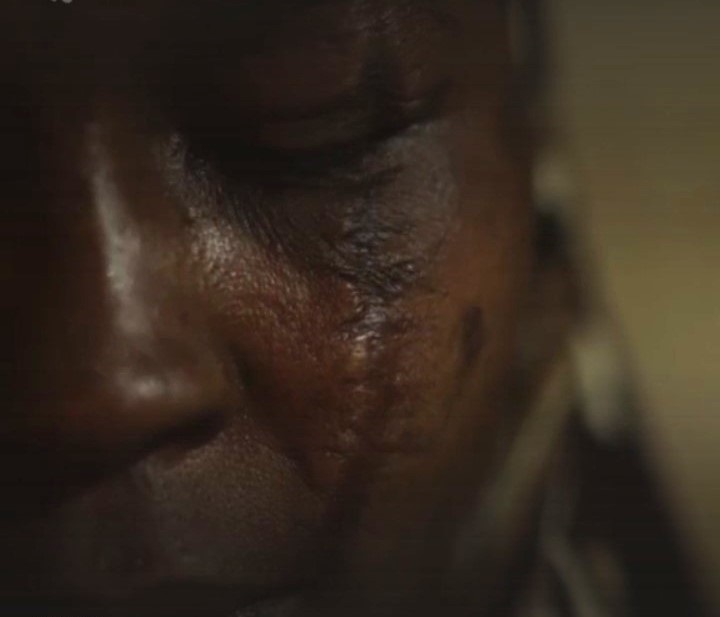
The scarred face of a girl in the red light district Tudun James, one of the most dangerous places in Zinder[78]
In the film, not all seems lost: there are organisations trying to change things. Convincing the boys that another life is possible is not easy: they were born and lived in this one reality, difficult to imagine others, except to dream of them as if they were actors in a film. Boys like the protagonists of Aicha Macky’s film, like Idrissa Sani Malan, the former head of a Palais, who for years lived by instilling terror in his fellow citizens, passing himself off as a hero similar to those in American films in which individual citizens become executioners, and do so in the name of characters they know nothing about, from Hitler (who for them is an American hero) to Tom Cruise. He is now an adult and works as a motorbike taxi driver, and is an example that something can be done: he says he underwent 18 months of training by an NGO, which changed him profoundly[79]. A small light in the deepest darkness, but still important.
The timing of politics is biblical: organisations such as the United Nations Population Fund (UNFPA), which since 2004 has set up more than 137 schools in Zinder to teach family planning, have shown that they make a real impact[80]; there is a constellation of NGOs trying to make a difference[81]. What is lacking is an intervention by the international community to make an impact at the political-institutional level: but Niger is a country that nobody cares about, except for its mineral wealth, firmly in the hands of French neo-colonialism. For this reason, Aicha Macky’s beautiful film should be imposed on those in Washington, Geneva and Brussels who hold the powerful levers that could change Niger, pacify a blood-soaked land, give it back a future through reforestation[82] and development programmes for local micro-economies. Without the Sahel, Africa will not make it. And if Africa does not make it, there is a serious risk that the whole of humanity is now doomed.
[1] https://www.taneter.org/niger.html
[2] https://www.bbc.com/news/world-africa-63280518
[3] https://blogs.worldbank.org/nasikiliza/understanding-poverty-and-reversals-five-charts-niger
[4] https://www.worldometers.info/world-population/niger-population/
[5] https://www.tandfonline.com/doi/full/10.1080/23311886.2020.1712156
[6] https://www.worldbank.org/en/country/niger/overview#:~:text=Niger%2C%20which%20is%20located%20in,in%20extreme%20poverty%20in%202021.
[7] https://www.bmz.de/en/countries/niger/economic-situation-55616
[8] https://www.ifrc.org/article/niger-urgent-action-needed-hunger-grips-communities
[9] https://civil-protection-humanitarian-aid.ec.europa.eu/where/africa/niger_en#:~:text=Niger%20continues%20to%20suffer%20significant,264%2C000%20people%20across%20the%20country.
[10] https://punchng.com/seven-die-five-missing-as-flood-sacks-niger-communities/
[11] https://world-nuclear.org/information-library/facts-and-figures/uranium-production-figures.aspx
[12] https://www.geopoliticalmonitor.com/uranium-in-niger-when-a-blessing-becomes-a-curse/
[13] https://african.business/2021/11/energy-resources/niger-an-attractive-nation-with-an-emerging-oil-industry/
[14] https://www.jeuneafrique.com/181991/politique/mahamadou-issoufou-lu-pr-sident-du-niger-avec-57-95-des-voix/
[15] https://www.reuters.com/article/us-niger-election-idUSKCN0VW1KQ
[16] https://www.bbc.com/news/world-africa-56175439
[17] https://freedomhouse.org/country/niger/freedom-world/2022
[18] https://freedomhouse.org/country/niger/freedom-world/2022
[19] https://www.eeas.europa.eu/delegations/nigeria/nigeria-eu-annual-report-human-rights-and-democracy-world-2021-country-updates_en?s=114
[20] https://freedomhouse.org/country/niger/freedom-world/2022
[21] https://observers.france24.com/en/africa/20220909-we-are-tired-of-living-like-prisoners-lgbt-asylum-seekers-stranded-in-niger
[22] https://journals.openedition.org/remi/8803
[23] https://reliefweb.int/report/niger/situation-ecowas-citizens-stranded-niger-course-migrating-europe-ecowas-sends-high-level-and-technical-assessment-mission
[24] https://www.clingendael.org/sites/default/files/pdfs/irregular_migration_and_human_smuggling_networks_in_niger_0.pdf “Irregular migration and human smuggling networks in Niger” – Fransje Molenaar – The Clingendael Institute – February 2017
[25] https://www.clingendael.org/sites/default/files/pdfs/irregular_migration_and_human_smuggling_networks_in_niger_0.pdf “Irregular migration and human smuggling networks in Niger” – Fransje Molenaar – The Clingendael Institute – February 2017
[26] https://www.rfi.fr/fr/afrique/20161216-le-flux-migrants-le-niger-pratiquement-reduit-neant
[27] https://www.studiokalangou.org/51426-les-anciens-passeurs-d-agadez-fatigues-d-attendre-que-les-promesses-soient-tenues
[28] https://www.limesonline.com/cartaceo/ad-agadez-dove-si-vive-di-migrazioni
[29] https://constellis-production-tmp.s3.amazonaws.com/uploads/document/file/112/CONSTELLIS_CONFIDENTIAL_JNIM_Group_Profile_February_2019.pdf
[30] https://www.bbc.com/news/world-africa-13809501
[31] https://issat.dcaf.ch/fre/layout/set/fullscreen/Apprendre/La-bibliotheque-des-ressources/Recherches-et-documents-strategiques/Facing-the-Challenge-of-the-Islamic-State-in-West-Africa-Province
[32] https://ecfr.eu/special/sahel_mapping/isgs
[33] https://www.csis.org/blogs/examining-extremism/examining-extremism-jamaat-nasr-al-islam-wal-muslimin
[34] https://www.amnesty.it/appelli/niger-stop-ai-bambini-soldato/#:~:text=Sebbene%20altri%20gruppi%20armati%20operino,civili%20e%20attacchi%20alle%20scuole.
[35] https://www.ispionline.it/en/pubblicazione/proliferation-armed-non-state-actors-sahel-evidence-state-failure-29329
[36] https://www.actuniger.com/societe/18461-scandales-a-repetition-securite-bafouee-tlp-niamey-met-le-doigt-dans-la-plaie-et-dit-non.html
[37] https://issafrica.org/iss-today/organised-banditry-is-destroying-livelihoods-in-nigers-borderlands
[38] https://www.researchgate.net/publication/254798431_New_mobilities_and_insecurities_in_Fulbe_nomadic_societies_a_multi-country_study_in_west-central_Africa_Niger-Nigeria
[39] https://www.icij.org/investigations/fincen-files/niger-scandal-of-the-century-exposed-in-fincen-files-sparks-lawsuit-demanding-action/ ; https://tradingeconomics.com/niger/corruption-index ; https://www.aljazeera.com/news/2022/5/13/niger-ngos-file-complaint-over-alleged-loss-of-99-m-in-state-funds
[40] https://crisis24.garda.com/insights-intelligence/intelligence/country-reports/niger
[41] https://tournonslapageniger.org/
[42] https://crisis24.garda.com/insights-intelligence/intelligence/country-reports/niger
[43] https://www.stat-niger.org/wp-content/uploads/2020/05/Rapport_Personnes_Agees.pdf
[44] https://twitter.com/bgaitou/status/668089456830885888
[45] https://www.everyculture.com/wc/Mauritania-to-Nigeria/Hausa.html
[46] https://books.google.it/books?hl=en&lr=&id=OaGrDwAAQBAJ&oi=fnd&pg=PA319&dq=fada+Lund,+2009:+103&ots=-0TYp2vte-&sig=6K5WGdE11hzX3gsjO9n–tVUCT4#v=onepage&q=fada%20Lund%2C%202009%3A%20103&f=false “Identités sahéliennes en temps de crisi: Histoires, enjeux et prospects” – Amy Niang – 2009 – Chap. 13
[47] https://books.google.it/books?hl=en&lr=&id=OaGrDwAAQBAJ&oi=fnd&pg=PA319&dq=fada+Lund,+2009:+103&ots=-0TYp2vte-&sig=6K5WGdE11hzX3gsjO9n–tVUCT4#v=onepage&q=fada%20Lund%2C%202009%3A%20103&f=false “Identités sahéliennes en temps de crisi: Histoires, enjeux et prospects” – Amy Niang – 2009 – Chap. 13
[48] https://journals.openedition.org/cdg/421?lang=en
[49] https://www.nigerdiaspora.net/33-societe/800-le-brigandage-a-zinder-la-loi-des-palais
[50] https://www.nigerdiaspora.net/33-societe/800-le-brigandage-a-zinder-la-loi-des-palais
[51] https://massagonago.blogspot.com/
[52] https://www.files.ethz.ch/isn/190086/Complete%20Journal.pdf page 60
[53] https://pulitzercenter.org/stories/dead-mans-market-and-boy-gangs-niger
[54] https://www.nigerdiaspora.net/33-societe/800-le-brigandage-a-zinder-la-loi-des-palais
[55] https://www.nigerdiaspora.net/33-societe/800-le-brigandage-a-zinder-la-loi-des-palais
[56] https://base.afrique-gouvernance.net/docs/youth-violence-fr.pdf
[57] https://www.crisisgroup.org/africa/sahel/niger/301-sud-ouest-du-niger-prevenir-un-nouveau-front-insurrectionnel
[58] https://www.bbc.com/news/world-africa-63255695
[59] https://www.bbc.com/news/world-africa-63255695
[60] https://www.dandc.eu/en/article/niger-africas-new-oil-exporting-nation
[61] https://archipress.org/docs/pdf/undp/Rapport_Niger.pdf UNDP – Centre Pour Le Dialogue Humanitaire – Instrumentalisation Religieuse et Economie de l’Insécurité Ce Que Disent 800 Sahéliens – Rapport National Niger – HD Centre 2016 – Page 3
[62] https://www.cath.ch/newsf/niger-sept-organisations-islamistes-interdites-apres-les-emeutes-contre-le-fima/
[63] https://www.bbc.com/afrique/region/2012/09/120916_niger_church_attack
[64] https://journals.sagepub.com/doi/full/10.1177/000203971505000104
[65] https://www.opendoorsusa.org/christian-persecution/world-watch-list/niger/
[66] https://base.afrique-gouvernance.net/docs/youth-violence-fr.pdf “La Violence Des Jeunes et les Enjeux De l’Extremisme Violent a Zinder” – OIM 2017 – Page 21
[67] https://foreignpolicy.com/2016/03/08/dead-mans-market-and-the-boy-gangs-of-niger-boko-haram/
[68] https://foreignpolicy.com/2016/03/08/dead-mans-market-and-the-boy-gangs-of-niger-boko-haram/
[69] https://foreignpolicy.com/2016/03/08/dead-mans-market-and-the-boy-gangs-of-niger-boko-haram/
[70] https://foreignpolicy.com/2016/03/08/dead-mans-market-and-the-boy-gangs-of-niger-boko-haram/
[71] https://foreignpolicy.com/2016/03/08/dead-mans-market-and-the-boy-gangs-of-niger-boko-haram/
[72] https://www.visionsdureel.ch/en/film/2021/zinder/
[73] https://africanarguments.org/2016/06/are-we-animals-nigeriens-respond-to-foreign-policys-dead-mans-market/
[74] https://africanarguments.org/2016/06/are-we-animals-nigeriens-respond-to-foreign-policys-dead-mans-market/
[75] https://africanarguments.org/2016/06/are-we-animals-nigeriens-respond-to-foreign-policys-dead-mans-market/
[76] https://www.arte.tv/fr/videos/096314-000-A/zinder/
[77] https://revues.acaref.net/wp-content/uploads/sites/3/2021/12/ISSA-Issoufou-ET-OUMAROU-Issoufou-.pdf
[78] https://www.arte.tv/fr/videos/096314-000-A/zinder/ minute 52:06
[79] https://www.arte.tv/fr/videos/096314-000-A/zinder/ minute 15:30
[80] https://www.unfpa.org/data/transparency-portal/unfpa-niger
[81] https://www.pseau.org/outils/organismes/organisme_resultat.php?pays_iso[]=NE&org_ville=Zinder&l=fr
[82] https://ibiworld.eu/2021/07/10/tra-sogno-e-speranza-il-progetto-della-grande-muraglia-verde/
Leave a Reply